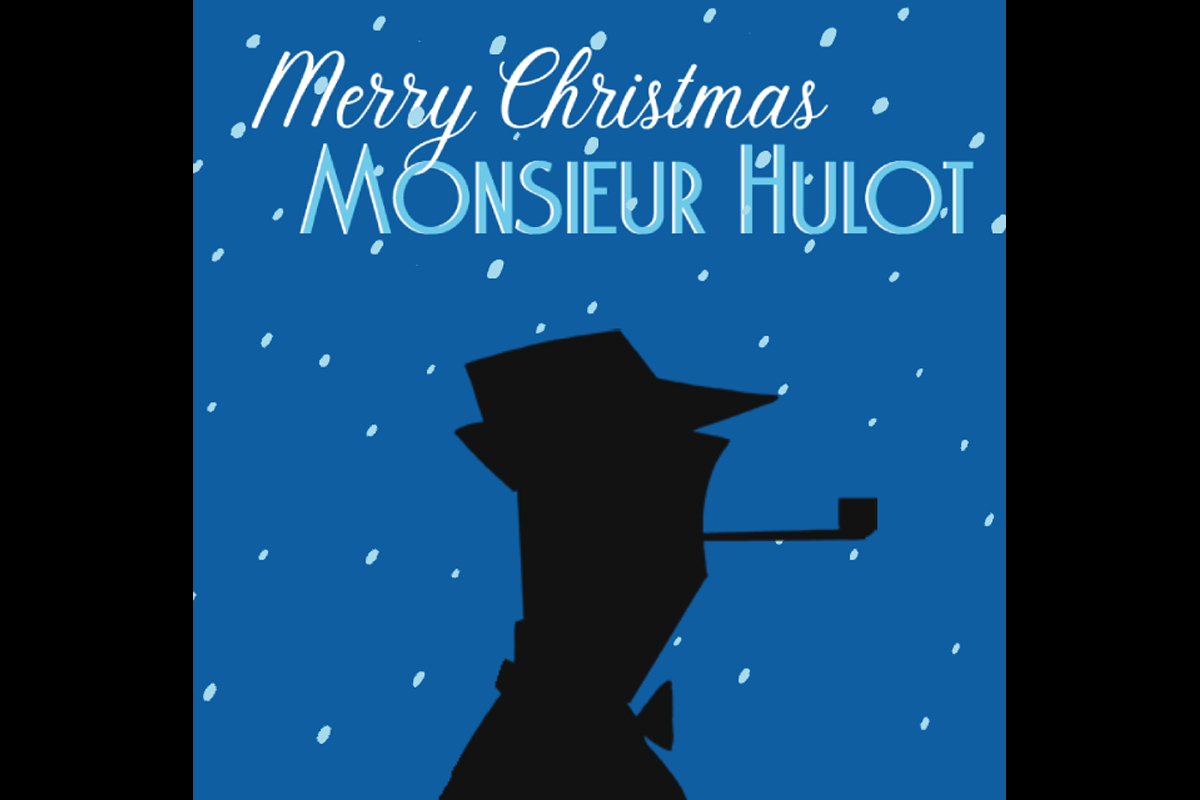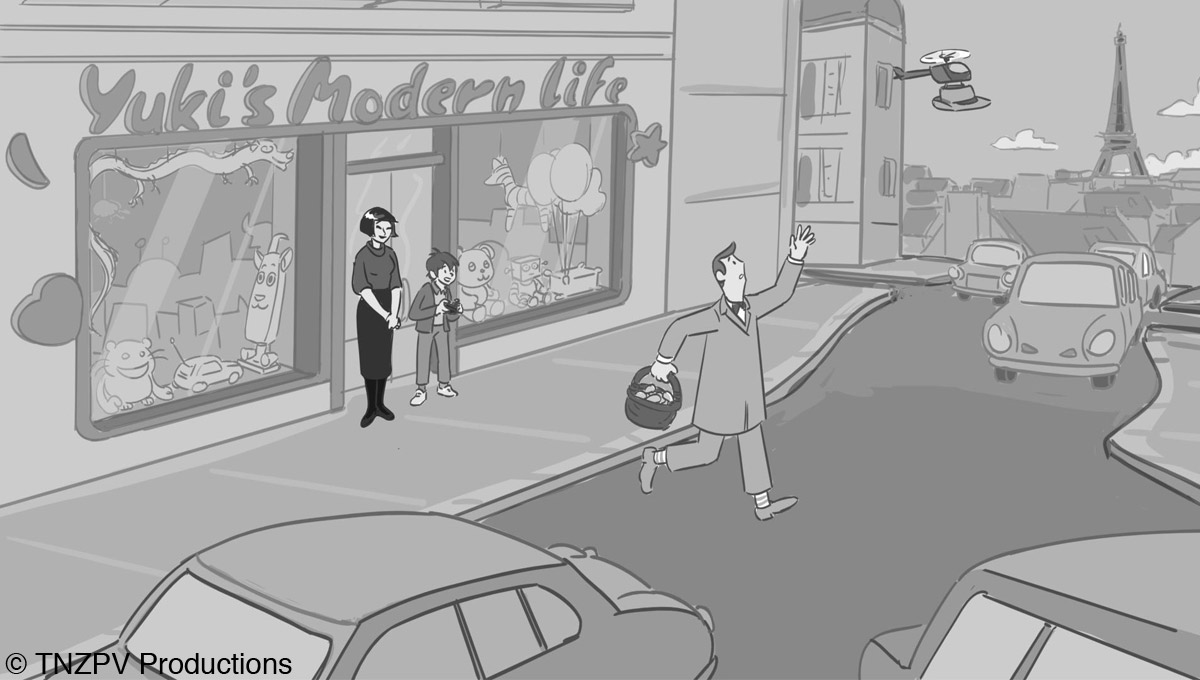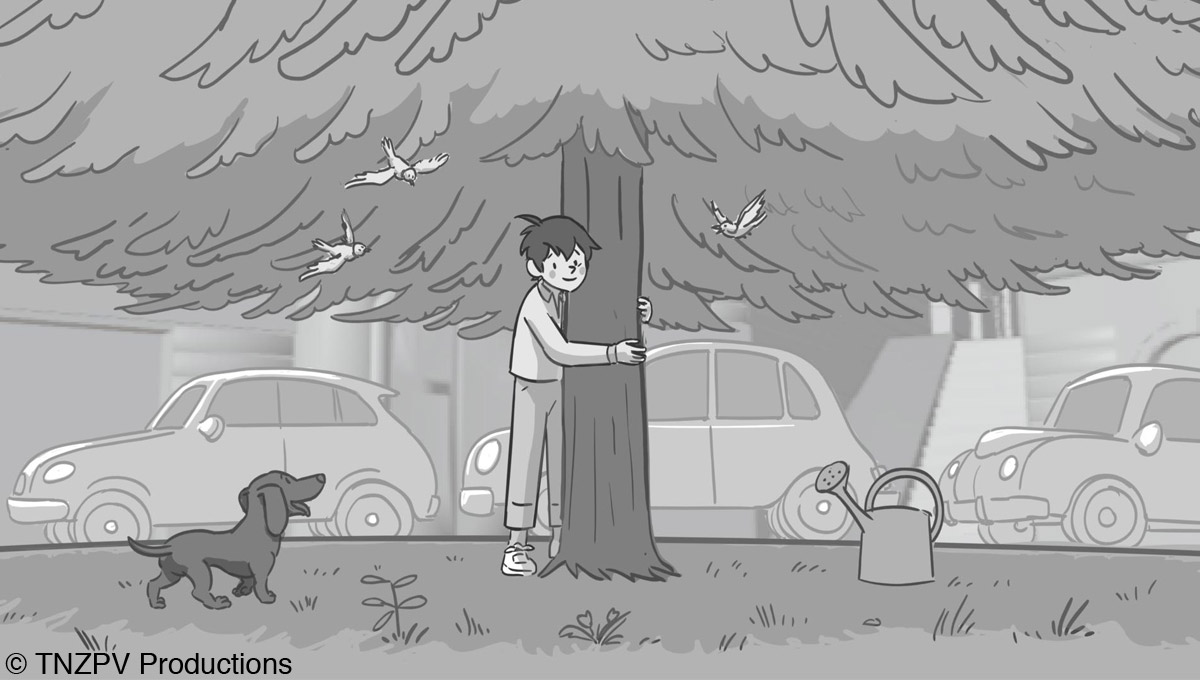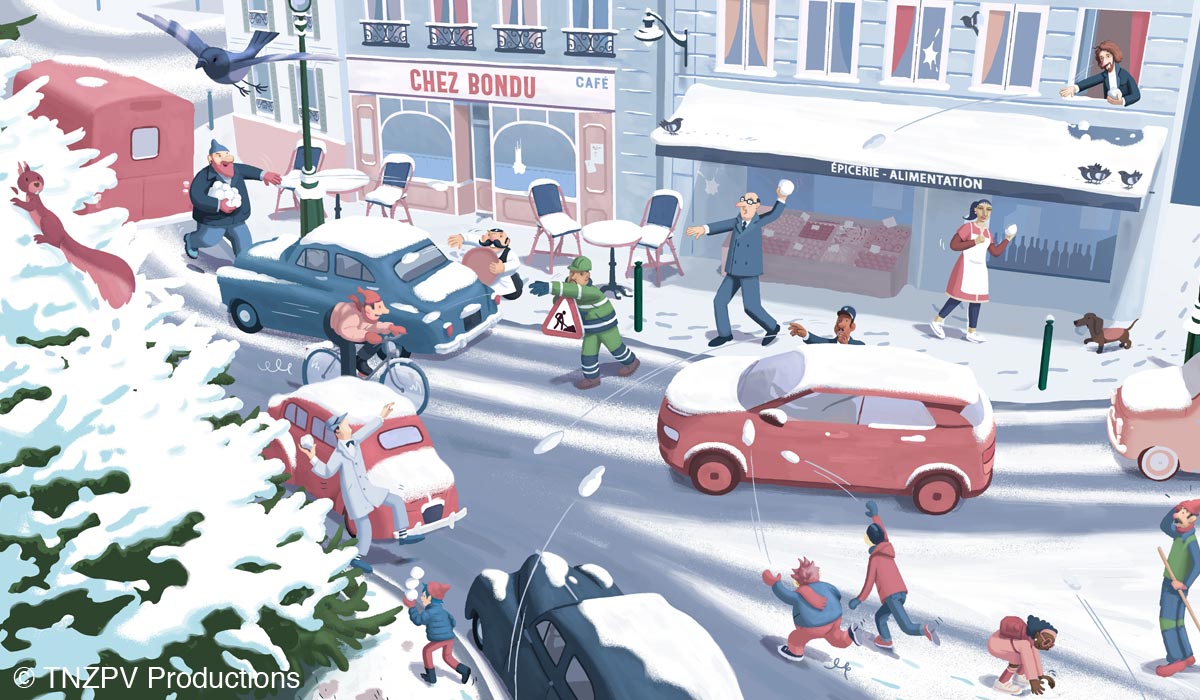Merry Christmas Monsieur Hulot
(Status: In Development)
Synopsis
Christmas time is over. Monsieur Hulot’s Christmas tree is dying. He decides to save it and plant it right in the middle of the rotary, the only remaining plot of land in this urban environment. Hulot is helped by his little neighbour, Louis, a great fan of his whimsy and eccentricities – much to the discontent of his father, who happens to be the borough mayor. But the tree grows so tall that it creates a joyful chaos! So much so that by the following Christmas, the mayor decides to get rid of it, and thereby end the bond his son shares with Hulot. The decision is made to chop the tree down! But instead, with the help of Louis, Hulot, a bit of snow, a little touch of magic and a lot of love, life turns into a “jour de fête”, a never-ending celebration!
Merry Christmas Monsieur Hulot
Directors: Céline Willard and Marc Rius
Scriptwriter: Marc Rius
Graphic Author: David Merveille
Producers: Aubane Fillon, Thomas Giusiano, and Mathieu Rey (TNZPV Productions, France)
Target audience: Children (6 – 8 years old)
Techniques: 3D digital
Format: 75’
Merry Christmas Monsieur Hulot is an animated feature film project with an amusing story of family fun, featuring lovely visuals with gentle color palettes. The project was pitched at Cartoon Movie 2023.
Monsieur Hulot, the main character, is a direct inspiration from and pays homage to Jacques Tati and his French classic comedy films, ly Les Vacances de Monsieur Hulot (1953), Mon Oncle (1958), Playtime (1967), and Trafic (1971).
It is a film where we can calmly observe a story that leads to a heart-warming ending, spun through daily episodes shown by the inhabitants around a roundabout in Paris. The film has soft and nostalgic visual style based on David Merveille’s picture books.
We interviewed Marc Rius, the director and scriptwriter of the film, on the story behind Merry Christmas Monsieur Hulot, with an additional question to Thomas Giusiano, producer, on the technical specifics behind the film.
Notice: We cannot yet show the trailer in this article, but we can still share with you some of the official visuals from the film project in development. However, they are work-in-progress, so they may not be the same as the final visuals of the film when it is completed.
Interview with Marc Rius and Thomas Giusiano
Hideki Nagaishi (HN): Could you let us know the film’s story, in brief?
Marc Rius: When Mister Hulot plants his Christmas tree amid the concrete in the middle of the local rotary, helped by his little neighbor Louis, nature symbolically comes back to town. Life becomes a merry mess, but this tree brings people together. Human relationships change, and the friendliness and the festive spirit are back.
HN: Could you let us know the key points of your animated feature film project that you would like to appeal to the prospective audience? What message or experience you want to deliver through this film the most?
Marc Rius: This film carries an ecological, societal and humanistic message, but we don’t want to be moralistic either. We wish to preserve the wonderment and the simple pleasure of a funny and poetic story, adapted to young audiences.
We are aware that the new generation doesn’t know much about Jacques Tati’s films. Although our new film is inspired by his works, which are known throughout the world, we put a child (Louis) at the centre of our story: an “heir” of Mister Hulot. Louis is an endearing character who brings his adventures to life, from the perspective of a child.
This original story humbly proposes to (re)discover Jacques Tati and his cinematic genius. While respecting his narrative’s codes, his staging and his sound work, we shall take the liberty to bring a touch of dynamism and modernity. The animation techniques we use allow that. And there is also the freshness of the graphic work by David Merveille.
HN: How did the film project start, and how did Céline Willard come to co-direct the film?
Marc Rius: The idea of this film comes first from my passion for Jacques Tati’s works: his sense of slapstick, his humor and his poetry. His aesthetic inspires a fresh appreciation of the world. The idea of this film also comes from my encounter with the Belgian illustrator David Merveille and the universe of his elegant graphic work. Giving movement to these drawings is very interesting to me.
The adaptation seems simple, but this is not the case: the hard part is finding the power of simplicity! With my co-director Céline Willard, I’m in no doubt that we have a strongly-driven pairing in place. I started working with Céline on the storyboard and we got along very well. So, I asked her to be my co-director. She’s more technical than me, but our trajectories have enriched our artistic glances, our sensibilities, and our skills. Our visions greatly complement each other: on staging, the accuracy of animation, the graphic coherence, and the spirit of the movie… Moreover, a woman’s perspective is always precious!
HN: Where did the initial idea of the story and characters come from?
Marc Rius: It’s a long story… Before becoming a feature film, this project underwent several rebounds. First, I wrote a short film where Mister Hulot was in a carnival. Then, I wrote a TV special (3×26’). And finally, I kept only the context of this special: the Christmas season, and I wrote this new story. It’s like a Christmas tale but without Santa Claus. In a way, Mister Hulot is a new “Santa Claus”.
A few characters are inspired, with a certain distance, by “figures” from Tati’s movies. But most characters are invented. They have roles easy to recognize in this “micro-society”. When Mister Hulot and Louis plant the Christmas tree, some people are for it, some people are against it: a smiling struggle. Each character is a piece of the puzzle, with his or her own defined trajectory that will eventually be dragged into a new narrative.
This is an ensemble movie where everything takes place on the square where Hulot lives: a microcosm turned into a theater stage; the rotary becomes the epicenter of a merry “earthquake” which shakes up local life. At the end, everyone is gathered around the tree, but Louis has the most important trajectory: The young boy will find a father, his father. At several levels, the notion of transmission is throughout the film.
HN: What do you take care in the most when writing the film’s story?
Marc Rius: There is no dialogue in the film (only two or three repeated sentences). Attitudes, moves, colors, shapes, sounds, and intonations are the many visual and audio narrating elements that interlock, complete each other, resonate, and dialog with each other, weaving a detail-oriented treatment.
As a result, the script’s mechanical clockwork constitutes generous, refined and organic “character and environment” material. The gesture, the theatricality and the acting have been thought of and carefully wrote to understand emotion and intentions. The script is very precise: everything is choreographed.
Another important point: the script gives pride to the sound because is crucial to the narrative. No need to specify here how particular and rich Tati’s work on sound was.
Naturally, my main goal is to make our young audience laugh. I had to find a balance between comedy and emotion: a singular set of rhythms, a sense of timing as in Tati’s work.
For this complex drama structuring to work with apparent simplicity, our directorial approach should be altogether precise, rigorous, and mindful. We will need to play the narrative score with finesse, in a light-hearted way, for the film to feel like a “festive stroll”. Above all, I wanted my writing to make people happy.
HN: What is the most important characteristic and goal of the film’s visual design of the characters and the setting/backgrounds/environment?
Marc Rius: The filmmaking will respect Jacques Tati’s distinct “plots”, but using 3D animation (2D-rendered CGI) as a production tool will enable us to draw our inspiration fully from David Merveille’s narrative style and aesthetics, offering a new approach to this cinematographic work. Through a sleek, minimalist and legible design, we will produce vibrant art, an open door to an imaginary world of whims and creativity.
This is how we intend to modernize the visual language of a unique moviemaker. The thoughtful use of 3D animation offers options that are impossible to shoot using live-action techniques. Indeed, we will be able to play around with shapes and their metamorphosis, with visual counterpoints and misunderstandings, with some of the volumes’ malleability or depth.
We can invent a unique photography direction where light and colorimetry change at will as the film’s plot and emotions evolve. We will play with the “camaïeux” of David Merveille’s style: the harmony of colors emphasizes the friendly atmosphere.
We also want to stay away from the technological coldness of 3D and bring pictorial matter to the screen. We will pay great attention to creating the most important atmosphere of this story: the magical context of Christmas holidays in a snow-covered Paris. We will ensure the movie has a feel-good vibe, for the audience to view it as if cozily wrapped in a snug “cocoon”.
HN: Could you please let us know the story behind the creation of the visual aspects of the trailer?
Thomas Giusiano: A few months ago, we had our first artistic and technical test. We tried to be as close as possible to David Merveille’s style. The results, even if they were promising, were missing details. It was a little bit too perfect, too pure… too 3D. For this trailer, we decided to add more details in the modelling, but not so much and add some slightly detailed brushed textures. We wanted to keep the color scheme of David. Work with a camaieu of colors responding to each other. The image needs to be soft and warm, but with sharp shadows. It was a real challenge, but the result is here. We of course need to do a lot of more work to improve the quality, to have more appealing color schemes, and to test many technical aspects we will be facing during the movie.
The artistic bias of this feature film is to make CG animation invisible! We have to let ourselves be carried away by the work of design, colors, lighting and the poetry of Mr. Hulot’s character.
TNZPV has great artistic resources, but also recognized technical knowledge. Our pipeline relies primarily on the open-source software Blender, Guerilla Render, Houdini as well as Nuke and Adobe Substance 3D Painter. We are investigating Unreal Engine integration as well. The flexibility of Blender allows us to create and use tools that make the work of artists easier. Our asset manager communicates with Kitsu, an open source prod tracker from CGWire, that saves time in production: assets are checked, versioned, saved and replicated automatically!
We aim to put in the artist’s hands the edge of TNZPV’s technology for this feature film.
HN: Could we hear about your vision for the film’s music?
Marc Rius: The original music is composed by Bruno Fontaine. He knows the cinema of Jacques Tati very well. The music of Bruno – thrilled to reconnect with Tati after the “Hulophonies” he composed for the 2022 Cannes Festival – will highlight the comical features and bring an invigorating boost to the emotions. His writing offers a wonderful association between classicism, mischief, and rowdiness. We will therefore plan the filming for the movie to unfold along an original score, full of whimsy and surprises.

















